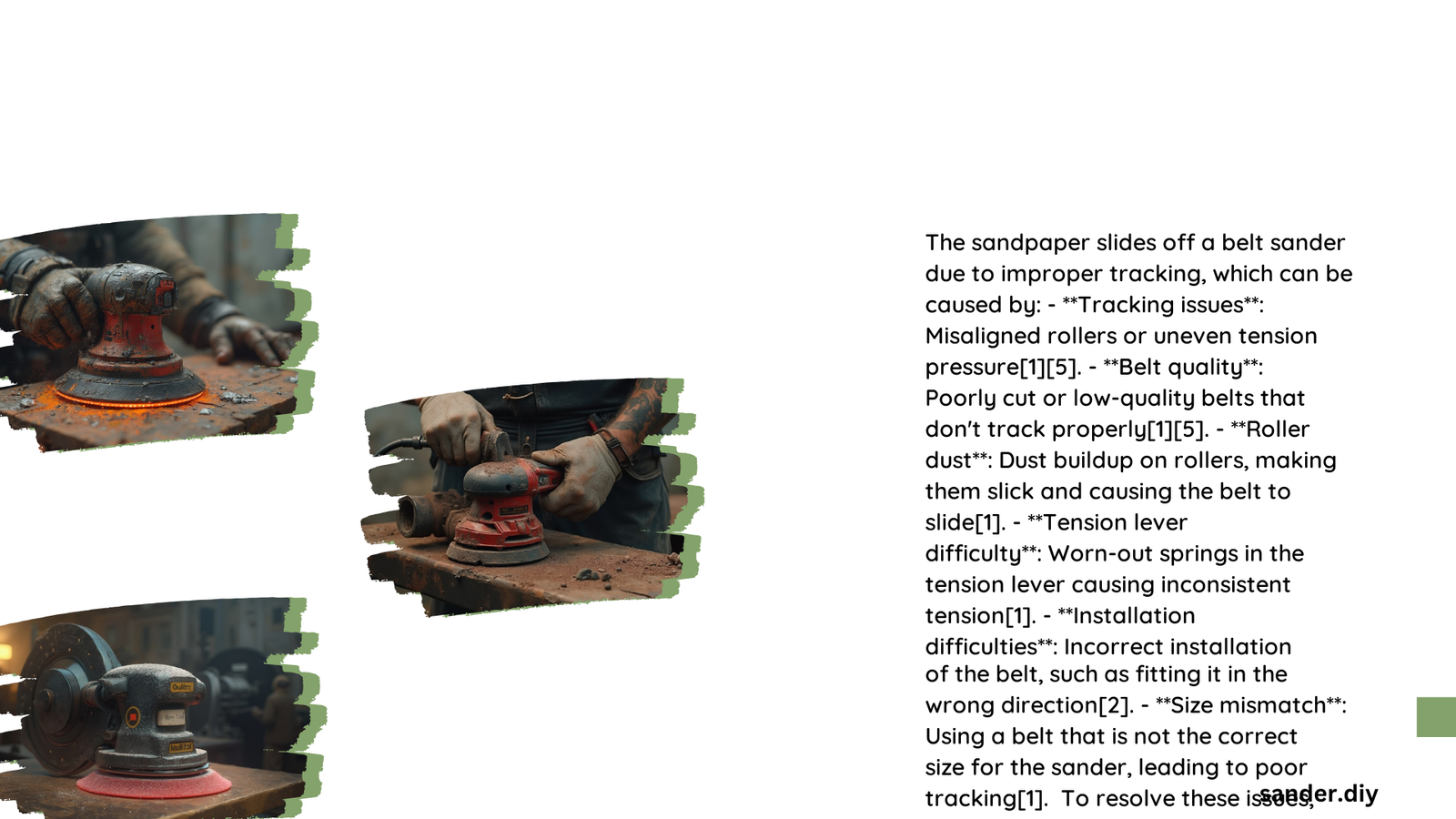Sandpaper sliding off a belt sander is a common issue that can disrupt work and potentially damage the tool or workpiece. This problem often stems from improper belt installation, worn components, or incorrect sandpaper type. Understanding the causes and implementing proper solutions can significantly improve sanding efficiency and prevent frustrating interruptions during projects.
What Are the Main Causes of Sandpaper Sliding Off a Belt Sander?
Several factors can contribute to sandpaper sliding off a belt sander:
- Improper belt tension
- Misaligned rollers
- Worn or damaged rollers
- Incorrect sandpaper size
- Damaged or poorly joined sandpaper
- Excessive pressure during sanding
- Accumulation of debris on rollers or sandpaper
How Does Improper Belt Tension Affect Sandpaper Stability?
Proper belt tension is crucial for keeping the sandpaper in place during operation. If the tension is too loose, the belt can easily slip off the rollers. Conversely, if it’s too tight, it can cause excessive wear on both the sandpaper and the sander components.
To ensure proper tension:
- Consult your sander’s manual for specific tension requirements
- Use the tension adjustment mechanism on your sander
- Check the tension before each use
- Replace worn tension springs if necessary
What Role Do Misaligned Rollers Play in Sandpaper Slippage?

Misaligned rollers can cause the sandpaper to track improperly, leading to slippage. This issue often results from:
- Wear and tear over time
- Improper assembly after maintenance
- Impact damage to the sander
To address roller alignment:
- Visually inspect the rollers for any obvious misalignment
- Use a straight edge to check roller parallelism
- Adjust roller positions according to manufacturer instructions
- Replace damaged rollers if necessary
How Can Worn or Damaged Rollers Contribute to the Problem?
Rollers that are worn or damaged can fail to grip the sandpaper properly, causing it to slide off. Signs of roller wear include:
- Visible grooves or indentations
- Uneven surfaces
- Cracks or chips
To maintain roller integrity:
- Regularly inspect rollers for signs of wear
- Clean rollers after each use to prevent debris buildup
- Replace rollers when wear becomes apparent
Why Is Correct Sandpaper Size Crucial for Preventing Slippage?
Using the wrong size sandpaper can lead to improper fit and tracking issues. To ensure you’re using the correct size:
- Check your sander’s specifications for the required belt dimensions
- Measure the existing belt if you’re unsure of the size
- Always purchase sandpaper belts that match your sander’s exact specifications
| Sander Type | Common Belt Sizes |
|---|---|
| Handheld | 3\” x 18\”, 3\” x 21\”, 4\” x 24\” |
| Benchtop | 4\” x 36\”, 6\” x 48\” |
| Stationary | 6\” x 89\”, 8\” x 164\” |
How Can Damaged or Poorly Joined Sandpaper Cause Slippage?
Sandpaper belts with damaged joints or poor manufacturing can easily come apart during use. To avoid this:
- Inspect new belts for any visible defects before installation
- Avoid folding or creasing sandpaper belts during storage
- Store belts in a cool, dry place to prevent deterioration
- Replace belts at the first sign of joint failure or excessive wear
What Impact Does Excessive Pressure Have on Sandpaper Stability?
Applying too much pressure during sanding can cause the belt to stretch and slip. To maintain proper pressure:
- Let the sandpaper do the work – avoid pressing down too hard
- Use a light touch and multiple passes for better results
- Consider using a coarser grit if more material removal is needed
How Does Debris Accumulation Affect Belt Sander Performance?
Buildup of sawdust and debris on rollers or sandpaper can interfere with proper tracking and cause slippage. To prevent this:
- Clean rollers and sandpaper regularly during use
- Use a brush or compressed air to remove debris
- Consider using a dust collection system with your sander
What Are Effective Solutions to Prevent Sandpaper from Sliding Off?
To keep your sandpaper in place and improve sanding efficiency:
- Ensure proper belt tension
- Regularly check and adjust roller alignment
- Use the correct size and type of sandpaper for your sander
- Inspect belts for damage before use
- Apply appropriate pressure during sanding
- Keep rollers and sandpaper clean
- Store sandpaper properly to maintain its integrity
By addressing these factors, you can significantly reduce the likelihood of sandpaper sliding off your belt sander, leading to more productive and frustration-free sanding sessions.
What Maintenance Steps Can Prolong Belt Sander Life and Prevent Slippage?
Regular maintenance is key to preventing sandpaper slippage and extending the life of your belt sander:
- Clean the sander after each use
- Lubricate moving parts as recommended by the manufacturer
- Check and tighten any loose screws or bolts
- Inspect electrical cords for damage (for electric sanders)
- Store the sander in a dry, clean environment
By following these maintenance steps, you can ensure your belt sander operates at peak performance and minimize the risk of sandpaper sliding off during use.
References:
1. Top 8 Wide Belt Sanding Problems & How To Solve Them
2. Common Wide Belt Sander Problems & Solutions
3. Common Sanding Belt Problems and Possible Solutions
